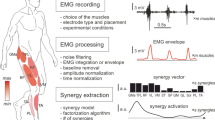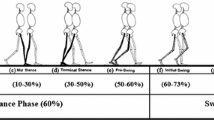Abstract
Purpose
Some factors such as gender, age, physical fitness, and manual dominance are relevant and can influence the recognition of movement patterns using electromyography (EMG). In this scenario, we present an EMG signal analysis for men and women to observe if there is any significant difference.
Methods
Data from 10 men and 10 women were acquired during the execution of six hand gestures (wrist flexion, wrist extension, wrist flexion to left, wrist extension to right, supination, and pronation) using eight channels armband. Four EMG time-domain signal features were extracted and hand gestures were classified using linear and quadratic discriminant analysis (LDA, QDA), and k-nearest neighbors (KNN) algorithms.
Results
Data of the feature difference absolute standard deviation value (DASDV) and waveform length (WL) were analyzed based on polar and bar graphs. KNN with 1 nearest neighbor obtained the best results between the classifiers for both men and women. For statistical analyses, the Wilcoxon-Mann-Whitney and Tukey post hoc in Friedman tests were used. The results show that there is no significant difference between data from different genders.
Conclusion
After analyzing the results obtained and extensive comparison with related works, it was concluded that, for the conditions where the electrodes are positioned equidistantly, evaluating all the muscular groups of a limb (armband format), there was no significant difference observed between the data from different genders. In addition, this allows us to conclude that EMG armband on the forearm can be a good option for robotic systems control without the need for prior gender adjustment.






Similar content being viewed by others
References
Abbaspour S, Lindén M, Gholamhosseini H, Naber A, Ortiz-Catalan M. Evaluation of surface EMG-based recognition algorithms for decoding hand movements. Med Biol Eng Comput. 2020;58:83–100. https://doi.org/10.1007/s11517-019-02073-z.
Ahamed NU, Yusof Z, Bin MD, Alqahtani M, Altwijri O, SAMM R, et al. Gender effects in surface electromyographic activity of the biceps brachii muscle during prolonged isometric contraction. Procedia Comp Sci. 2015;61:448–53. https://doi.org/10.1016/j.procs.2015.09.185.
Anders C, Brose G, Hofmann GO, Scholle H-C. Gender specific activation patterns of trunk muscles during whole body tilt. Eur J Appl Physiol. 2007;101:195–205. https://doi.org/10.1007/s00421-007-0490-z.
Arjunan S, Kumar D, Kalra C, Burne J, Bastos T. Effect of age and gender on the surface electromyogram during various levels of isometric contraction. In: 2011 Annual International Conference of the IEEE Engineering in Medicine and Biology Society. Boston: IEEE; 2011. p. 3853–6. https://doi.org/10.1109/IEMBS.2011.6090957.
Boostani R, Moradi MH. Evaluation of the forearm EMG signal features for the control of a prosthetic hand. Physiol Meas. 2003;24:309–19. https://doi.org/10.1088/0967-3334/24/2/307.
Brochier T, Spinks RL, Umilta MA, Lemon RN. Patterns of muscle activity underlying object-specific grasp by the macaque monkey. J Neurophysiol. 2004;92:1770–82. https://doi.org/10.1152/jn.00976.2003.
Chandrakantha L. Learning ANOVA concepts using simulation, Proceedings of the 2014 Zone 1 Conference of the American Society for Engineering Education. Bridgeport: IEEE; 2014. p. 1–5. https://doi.org/10.1109/ASEEZone1.2014.6820644.
Côté-Allard U, Gagnon-Turcotte G, Laviolette F, Gosselin B. A low-cost, wireless, 3-D-printed custom armband for sEMG hand gesture recognition. Sensors. 2019;19:2811. https://doi.org/10.3390/s19122811.
Di Nardo F, Laureati G, Strazza A, Mengarelli A, Burattini L, Agostini V, et al. Is child walking conditioned by gender? Surface EMG patterns in female and male children. Gait Posture. 2017;53:254–9. https://doi.org/10.1016/j.gaitpost.2017.02.009.
Duda RO, Hart PE, Stork DG. Pattern classification. 2nd ed. New York: Wiley; 2001.
Dwivedi A, Kwon Y, McDaid AJ, Liarokapis M. A learning scheme for EMG based decoding of dexterous, in-hand manipulation motions. IEEE Trans Neural Syst Rehabil Eng. 2019;27:2205–15. https://doi.org/10.1109/TNSRE.2019.2936622.
Freer DR, Liu J, Yang G-Z. Optimization of EMG movement recognition for use in an upper limb wearable robot, 2017 IEEE 14th International Conference on Wearable and Implantable Body Sensor Networks (BSN). Eindhoven: IEEE; 2017. p. 202–5. https://doi.org/10.1109/BSN.2017.7936041.
Fukunaga K. Introduction to statistical pattern recognition. 2nd ed. Boston: Academic Press; 1990.
Geiger DE, Behrendt F, Schuster-Amft C. EMG muscle activation pattern of four lower extremity muscles during stair climbing, motor imagery, and robot-assisted stepping: a cross-sectional study in healthy individuals. Biomed Res Int. 2019;2019:1–8. https://doi.org/10.1155/2019/9351689.
Halabi R, El banna I, Malaeb R, Halabi R, Diab M. Novel Approach for Wireless EMG Database Collection: Applied to Muscle Building Workout Routine Optimization, 2019 Fifth international conference on advances in biomedical engineering (ICABME). Tripoli: IEEE; 2019. p. 1–4. https://doi.org/10.1109/ICABME47164.2019.8940157.
Han J, Kamber M. Data mining: concepts and techniques. 3rd ed. Burlington: Elsevier; 2011.
Herle S, Raica P, Lazea G, Robotin R, Marcu C, Tamas L. Classification of surface electromyographic signals for control of upper limb virtual prosthesis using time-domain features, 2008 IEEE International Conference on Automation, Quality and Testing, Robotics. Cluj-Napoca: IEEE; 2008. p. 160–5. https://doi.org/10.1109/AQTR.2008.4588902.
Hill EC, Housh TJ, Smith CM, Schmidt RJ, Johnson GO. Gender- and Muscle-Specific Responses During Fatiguing Exercise. J Strength Cond Res. 2018;32:1471–8. https://doi.org/10.1519/JSC.0000000000001996.
Hudgins B, Parker P, Scott RN. A new strategy for multifunction myoelectric control. IEEE Trans Biomed Eng. 1993;40:82–94. https://doi.org/10.1109/10.204774.
Hughes G, Dally N. Gender difference in lower limb muscle activity during landing and rapid change of direction. Sci Sports. 2015;30:163–8. https://doi.org/10.1016/j.scispo.2015.02.009.
Jamal MZ. Signal acquisition using surface EMG and circuit design considerations for robotic prosthesis. In: Naik GR, editor. Computational Intelligence in Electromyography Analysis - A Perspective on Current Applications and Future Challenges: InTechOpen; 2012. https://doi.org/10.5772/52556.
Jamaluddin FN, Ahmad SA, Noor SBM, Hasan WZW. Flexible bio-signals channels acquisition system for ECG and EMG application: IEEE; 2014. p. 1–4. https://doi.org/10.1109/SCORED.2014.7072996.
Kalra C, Kumar DK, Arjunan S. Age and gender related differences in surface electromyograms for various force levels of contraction. JMBE. 2012;32:405–10.
Kavanagh JJ, Smith KA, Minahan CL. Sex differences in muscle activity emerge during sustained low-intensity contractions but not during intermittent low-intensity contractions. Phys Rep. 2020;8. https://doi.org/10.14814/phy2.14398.
Khokhar ZO, Xiao ZG, Menon C. Surface EMG pattern recognition for real-time control of a wrist exoskeleton. Biomed Eng Online. 2010;9:41. https://doi.org/10.1186/1475-925X-9-41.
Khushaba RN, Shi L, Kodagoda S. Time-dependent spectral features for limb position invariant myoelectric pattern recognition, 2012 International Symposium on Communications and Information Technologies (ISCIT). Gold Coast: IEEE; 2012. p. 1015–20. https://doi.org/10.1109/ISCIT.2012.6380840.
Kienbacher T, Paul B, Habenicht R, Starek C, Wolf M, Kollmitzer J, et al. Age and gender related neuromuscular changes in trunk flexion-extension. J NeuroEngineering Rehabil. 2015;12:3. https://doi.org/10.1186/1743-0003-12-3.
Kim KS, Choi HH, Moon CS, Mun CW. Comparison of k-nearest neighbor, quadratic discriminant and linear discriminant analysis in classification of electromyogram signals based on the wrist-motion directions. CAP. 2011;11:740–5. https://doi.org/10.1016/j.cap.2010.11.051.
Kocak AT, Yilmaz A. Segmentation and classification of contractions in uterine 16 channels EMG signals for preterm birth prediction, 2018 26th Signal Processing and Communications Applications Conference (SIU). Izmir: IEEE; 2018. p. 1–4. https://doi.org/10.1109/SIU.2018.8404821.
Kundu A, Wu W-R. Wilcoxon-Mann-Whitney rank test-based filter for removing streak noise in transmitted DPCM images. IEEE Trans Commun. 1990;38:150–5. https://doi.org/10.1109/26.47847.
La Banca FM, Mendes JJA, Campos DP, Stevan SL. Hand gestures classification using multichannel sEMG armband. In: Costa-Felix R, Machado JC, Alvarenga AV, editors. XXVI Brazilian Congress on Biomedical Engineering, vol. 70/2. Singapore: Springer Singapore; 2019. p. 239–46. https://doi.org/10.1007/978-981-13-2517-5_37.
Lee S, Saridis G. The control of a prosthetic arm by EMG pattern recognition. IEEE Trans Autom Control. 1984;29:290–302. https://doi.org/10.1109/TAC.1984.1103521.
Mendes Júnior JJA, Pires MB, Vieira MEM, Okida S, Stevan Jr. SL. Desenvolvimento de armband com fusão de sEMG e giroscópio para identificação de grupos mulculares do braço, Foz do Iguaçu, Paraná; 2016, p. 528–31.
Mendes Junior JJA, Freitas MLB, Siqueira HV, Lazzaretti AE, Pichorim SF, Stevan SL. Feature selection and dimensionality reduction: an extensive comparison in hand gesture classification by sEMG in eight channels armband approach. Biomed Signal Proc Control. 2020;59:101920. https://doi.org/10.1016/j.bspc.2020.101920.
Mendes Junior JJA, Freitas MLB, Stevan SL, Pichorim SF. Recognition of libras static alphabet with MyoTM and multi-layer perceptron. In: Costa-Felix R, Machado JC, Alvarenga AV, editors. XXVI Brazilian Congress on Biomedical Engineering, vol. 70/2. Singapore: Springer Singapore; 2019. p. 413–9. https://doi.org/10.1007/978-981-13-2517-5_63.
Nabulsi A-A. Hand Gesture recognition via electromyographic (EMG) armband for CAD software control. [Thesis in Electrical Engineering]. Kansas City: University of Missouri–Kansas City; 2018.
Oskoei MA, Hu H. Support vector machine-based classification scheme for myoelectric control applied to upper limb. IEEE Trans Biomed Eng. 2008;55:1956–65. https://doi.org/10.1109/TBME.2008.919734.
Phinyomark A, Khushaba N, Scheme E. Feature extraction and selection for myoelectric control based on wearable EMG sensors. Sensors. 2018;18:1615. https://doi.org/10.3390/s18051615.
Phinyomark A, Phukpattaranont P, Limsakul C. Feature reduction and selection for EMG signal classification. ESA. 2012;39:7420–31. https://doi.org/10.1016/j.eswa.2012.01.102.
Phinyomark A, Quaine F, Charbonnier S, Serviere C, Tarpin-Bernard F, Laurillau Y. Feature extraction of the first difference of EMG time series for EMG pattern recognition. CMPB. 2014;117:247–56. https://doi.org/10.1016/j.cmpb.2014.06.013.
Phinyomark A, Thongpanja S, Quaine F, Laurillau Y, Limsakul C, Phukpattaranont P. Optimal EMG amplitude detectors for muscle-computer interface. 2013 10th International Conference on Electrical Engineering/Electronics, Computer, Telecommunications and Information Technology, Krabi, Thailand: IEEE; 2013, p. 1–6. doi: https://doi.org/10.1109/ECTICon.2013.6559485.
Pradeep C, George SK. Control of Stepper Motor Using Surface EMG Signals. IJAREEIE. 2015;4:8326–33. https://doi.org/10.15662/IJAREEIE.2015.0410038.
Riillo F, Quitadamo LR, Cavrini F, Saggio G, Pinto CA, Pasto NC, Sbernini L, Gruppioni E. Evaluating the influence of subject-related variables on EMG-based hand gesture classification. 2014 IEEE International Symposium on Medical Measurements and Applications (MeMeA), Lisboa: IEEE; 2014, p. 1–5. doi: https://doi.org/10.1109/MeMeA.2014.6860134.
Saidane Y, Ben Jebara S. EMG signal analysis for comprehension of genders differences behavior during pre-motor activity. 2016 International Symposium on Signal, Image, Video and Communications (ISIVC), Tunis, Tunisia: IEEE; 2016a, p. 325–30. doi: https://doi.org/10.1109/ISIVC.2016.7894009.
Saidane Y, Ben Jebara S. Features selection for analyzing the effect of preparation instruction on forearm muscles during pre-motor activity. 2016 24th European Signal Processing Conference (EUSIPCO), Budapest, Hungary: IEEE; 2016b, p. 1443–7. doi: https://doi.org/10.1109/EUSIPCO.2016.7760487.
Saikia A, Mazumdar S, Sahai N, Paul S, Bhatia D. Comparative study and feature extraction of the muscle activity patterns in healthy subjects, IEEE; 2016, p. 147–51. doi: https://doi.org/10.1109/SPIN.2016.7566678.
Sella O, Jones RD, Huckabee M-L. Age and gender effects on submental motor-evoked potentials. AGE. 2014;36:9735. https://doi.org/10.1007/s11357-014-9735-z.
Sharma S, Dubey AKr. Movement control of robot in real time using EMG signal, IEEE; 2012, p. 1–4. doi: https://doi.org/10.1109/ICPCES.2012.6508060.
Shi J, Cai Y, Zhu J, Zhong J, Wang F. SEMG-based hand motion recognition using cumulative residual entropy and extreme learning machine. Med Biol Eng Comput. 2013;51:417–27. https://doi.org/10.1007/s11517-012-1010-9.
Srinivasan D, Sinden KE, Mathiassen SE, Côté JN. Gender differences in fatigability and muscle activity responses to a short-cycle repetitive task. Eur J Appl Physiol. 2016;116:2357–65. https://doi.org/10.1007/s00421-016-3487-7.
St-Amant Y, Rancourt D, Clancy EA. Effect of smoothing window length on RMS EMG amplitude estimates. Proceedings of the IEEE 22nd Annual Northeast Bioengineering Conference, New Brunswick, NJ, USA: IEEE; 1996, p. 93–4. doi: https://doi.org/10.1109/NEBC.1996.503233.
Yavuz E, Eyupoglu C. A cepstrum analysis-based classification method for hand movement surface EMG signals. Med Biol Eng Comput. 2019;57:2179–201. https://doi.org/10.1007/s11517-019-02024-8.
Funding
This study was financed in part by the Coordenação de Aperfeiçoamento de Pessoal de Nível Superior - Brasil (CAPES) Finance Code 001 and supported by the Brazilian Ethical Committee in Human Research of FederUniversity of Technology - Paraná (CAAE 89638918.0.0000.5547).
Author information
Authors and Affiliations
Corresponding author
Ethics declarations
Conflict of interest
The authors declare that no competing interests.
Additional information
Publisher’s note
Springer Nature remains neutral with regard to jurisdictional claims in published maps and institutional affiliations.
Rights and permissions
About this article
Cite this article
Freitas, M.L.B., Junior, J.J.A.M., La Banca, W.F. et al. Study of the relevance of gender in the classification of hand gestures by electromyography-based recognition systems. Res. Biomed. Eng. 37, 361–373 (2021). https://doi.org/10.1007/s42600-021-00145-4
Received:
Accepted:
Published:
Issue Date:
DOI: https://doi.org/10.1007/s42600-021-00145-4




